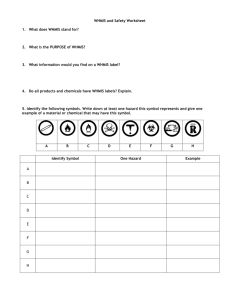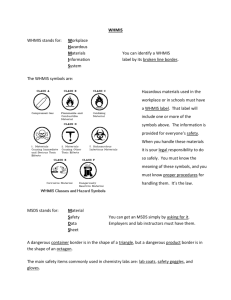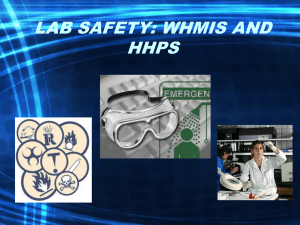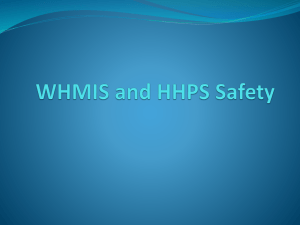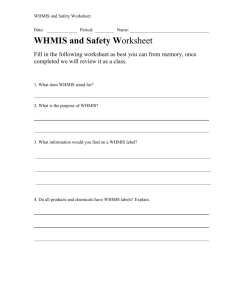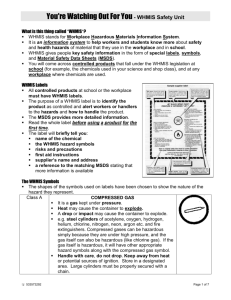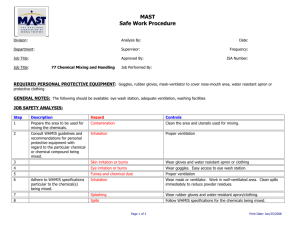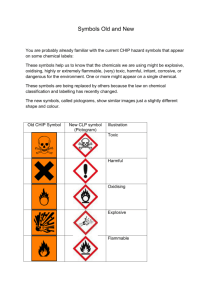WHMIS and Safety Worksheet - Answer key
advertisement
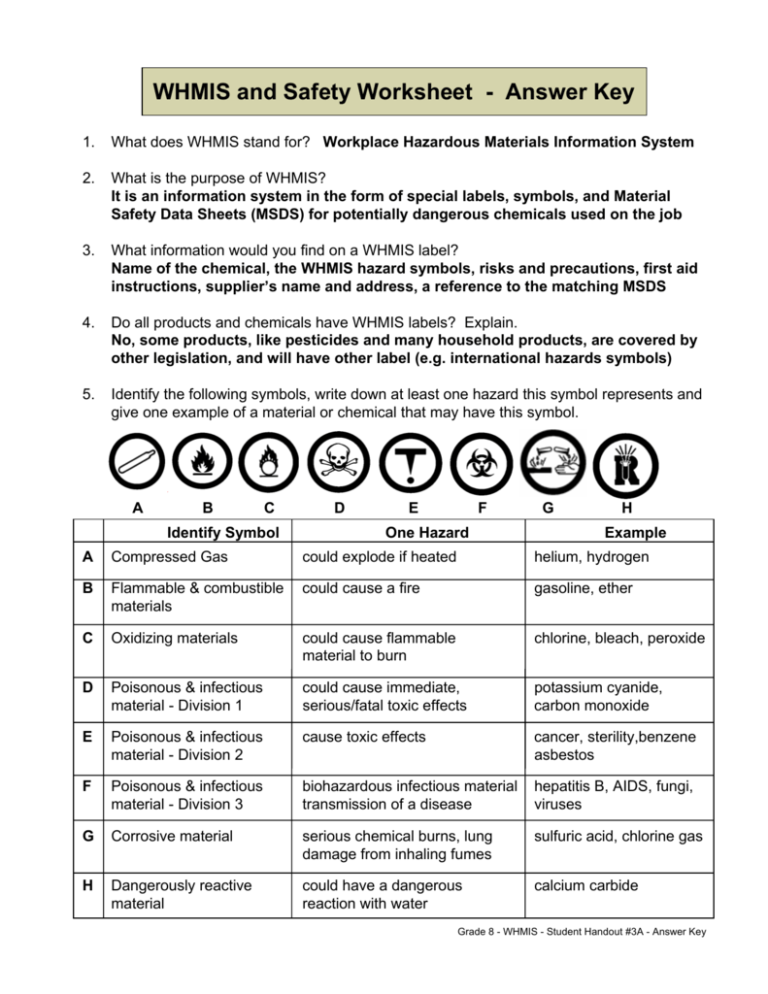
WHMIS and Safety Worksheet - Answer Key 1. What does WHMIS stand for? Workplace Hazardous Materials Information System 2. What is the purpose of WHMIS? It is an information system in the form of special labels, symbols, and Material Safety Data Sheets (MSDS) for potentially dangerous chemicals used on the job 3. What information would you find on a WHMIS label? Name of the chemical, the WHMIS hazard symbols, risks and precautions, first aid instructions, supplier’s name and address, a reference to the matching MSDS 4. Do all products and chemicals have WHMIS labels? Explain. No, some products, like pesticides and many household products, are covered by other legislation, and will have other label (e.g. international hazards symbols) 5. Identify the following symbols, write down at least one hazard this symbol represents and give one example of a material or chemical that may have this symbol. A B C Identify Symbol D E F One Hazard G H Example A Compressed Gas could explode if heated helium, hydrogen B Flammable & combustible materials could cause a fire gasoline, ether C Oxidizing materials could cause flammable material to burn chlorine, bleach, peroxide D Poisonous & infectious material - Division 1 could cause immediate, serious/fatal toxic effects potassium cyanide, carbon monoxide E Poisonous & infectious material - Division 2 cause toxic effects cancer, sterility,benzene asbestos F Poisonous & infectious material - Division 3 biohazardous infectious material transmission of a disease hepatitis B, AIDS, fungi, viruses G Corrosive material serious chemical burns, lung damage from inhaling fumes sulfuric acid, chlorine gas H Dangerously reactive material could have a dangerous reaction with water calcium carbide Grade 8 - WHMIS - Student Handout #3A - Answer Key 6. What is an MSDS, and what kind of information would be found on it? - An MSDS is a sheet that gives more detailed technical information about the product: product information, which hazardous ingredients are in the product, physical data, fire and explosive hazards, reactivity data, toxicological properties, preventive measures, first aid measures, when it was made and who to contact 7. Identify the following International Safety Symbols. A Danger Poison B Warning Poison C Caution Poison A D G J B E H K C F I D Danger Flammable E Warning Flammable F Caution Flammable G Danger Explosive H Warning Explosive I Caution Explosive J Danger Corrosive K Warning Corrosive L Caution Corrosive L Grade 8 - WHMIS - Student Handout #3B - Answer Key Safety in the Science Classroom - Answer Key For each of the following safety rules, give one GOOD reason why we have that safety rule. a) Never begin an experiment or lab without your teacher’s permission. Sample Answer: The teacher might have some important information you need to make the experiment work properly and safe. b) Keep your safety goggles on as long as there are any chemicals being used in the lab, even if you yourself are finished. A classmate still completing the lab might spill chemicals on you. c) Never eat, drink, or chew gum during a lab. Chemicals or biohazardous materials could be swallowed accidentally and poisonous substances could get on your fingers while eating. d) Put test tubes in a test tube rack before pouring liquids into them. The test tube will be held more steadily so there will be less chance that a spill will occur and since you are not holding the test tube, there will be less chance of the chemical spilling on you. e) Make sure your hands are dry when using electrical equipment. Water on hands could conduct electricity into your body if there is short circuit in the electrical device. f) Report any injuries, no matter how minor, to your teacher. The teacher should know so that he or she can correct a potentially hazardous situation and you will be protected if complications arise later on from the injury (e.g. infection). g) Always cut away from yourself and away from others when using a scalpel. If you cut toward yourself, the scalpel could suddenly slip and you could severely cut yourself. h) When diluting acid, always add small amounts of acid to large amounts of water. If you add water to a large amount of acid, the water could react with the acid even to the point of causing the glassware to break or an explosion to occur. i) If your clothing catches on fire, never run. Running will fan the flames causing them to spread faster. Therefore, stop, drop, roll or smother the flames with a blanket. j) When holding a bottle from which you are going to pour chemical, keep the label against the palm of your hand. If everyone does this, there will never be chemicals dipped or spilled onto the label of the bottle and therefore, when your skin touches the label, it won’t come into contact with any chemicals. k) If a chemical gets in your eye, flush it with running water for at least 15 minutes. Chemicals absorbed deep into the eye will only be drawn to the surface and flushed out by washing it with flowing water for at least 15 minutes. Grade 8 - WHMIS - Student Handout #5 - Answer Key


